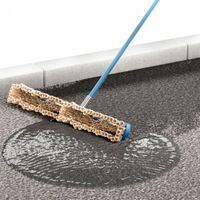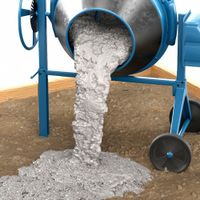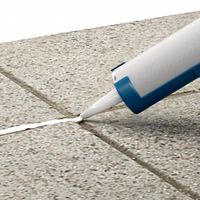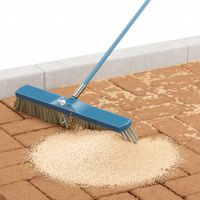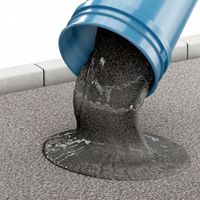Call +(254) 703 030 000 / 751 483 999 / 721 704 777
- Home
- Adhesives Sealants And Tape
- Concrete Asphalt Repair
.....Read More
Frequently Asked Questions
What is the best product for filling potholes in asphalt?
For filling potholes in asphalt, several products are available, each with specific advantages depending on the pothole's size, depth, and the traffic conditions. Cold patch asphalt is a popular choice for quick, temporary repairs. It's easy to use, requires no special equipment, and cures at ambient temperatures, making it ideal for DIY applications or emergency fixes. However, it may not last as long as hot mix asphalt.
Hot mix asphalt is the most durable solution, typically used by professionals for permanent repairs. It involves heating asphalt to a high temperature, allowing it to bond strongly with the existing pavement. This method provides a long-lasting, seamless repair but requires specialized equipment and expertise.
For smaller cracks or shallow potholes, asphalt emulsion sealants or crack fillers can be effective. These products are designed to prevent water penetration and further deterioration. For deeper or larger potholes, a multi-layered approach might be necessary, involving a base layer of aggregate followed by an asphalt patch.
When choosing a product, consider factors such as the pothole's size, the desired longevity of the repair, the climate, and your budget. Proper surface preparation, including cleaning debris from the pothole, is crucial for ensuring any repair product adheres effectively and lasts longer.
How do you repair cracks in concrete driveways?
To repair cracks in concrete driveways, begin by thoroughly cleaning the crack. Remove loose debris, dirt, and old caulk using a wire brush, vacuum, or air compressor. For deeper cracks, a chisel and hammer might be necessary to widen the crack slightly to ensure proper sealant penetration. Once clean, decide on the appropriate repair material.
For hairline cracks (less than 1/8 inch wide), a concrete crack filler or sealant is typically sufficient. Apply it according to the manufacturer's instructions, often by squeezing it directly into the crack and then smoothing it with a trowel or putty knife.
For wider cracks (1/8 inch to 1/2 inch), a more robust concrete crack repair caulk or polyurethane sealant is recommended. These products offer more flexibility and durability. Again, clean the crack thoroughly, and then apply the sealant, ensuring it fills the crack completely. You may need to use a backer rod in deeper cracks before applying the sealant to prevent excessive product usage and ensure proper adhesion.
For cracks wider than 1/2 inch or those that indicate structural issues, a more extensive repair might be needed, possibly involving patching compounds or professional intervention. For standard driveway cracks, however, the fillers and sealants mentioned are usually effective.
Allow the repair material to cure fully according to the manufacturer's directions before subjecting the driveway to traffic. Regular inspection and timely repair of cracks can significantly extend the lifespan of your concrete driveway.
What is the difference between cold-patch and hot-mix asphalt?
Cold-patch and hot-mix asphalt are two distinct materials used for paving and repairs, primarily differing in their application methods and composition.
Hot-mix asphalt (HMA) is the traditional and most common type of asphalt used for constructing new roads and major repairs. It is produced at high temperatures, typically between 250-325°F (121-163°C), by heating and mixing aggregate (like stone, sand, and gravel) with asphalt cement. The high temperature makes the asphalt binder fluid, allowing it to coat the aggregates thoroughly and compact densely, creating a strong, durable, and long-lasting pavement. HMA requires specialized equipment for transportation and application, as it must be laid and compacted while still hot. It sets as it cools, forming a rigid and stable surface.
Cold-patch asphalt, also known as cold-mix asphalt, is designed for temporary repairs or minor patching, especially in cold weather or for emergency situations where hot-mix asphalt is not practical. Unlike HMA, cold-patch asphalt is manufactured at ambient temperatures. It uses a different type of binder, often emulsified asphalt or cutback asphalt, which allows it to remain workable at lower temperatures. This means it can be stored in bags or drums and applied directly to potholes or cracks without heating. While convenient and easy to use, cold-patch asphalt is generally less durable and less resistant to heavy traffic and weathering than hot-mix asphalt. It compacts to a lesser density and is more susceptible to deformation and breakdown over time, making it a temporary fix rather than a permanent solution for significant pavement issues.
How long does it take for concrete patching compounds to cure?
The curing time for concrete patching compounds can vary significantly depending on several factors, including the specific product used, temperature, humidity, and the thickness of the patch. Generally, most concrete patching compounds will achieve initial set within a few hours (typically 2-8 hours), meaning they are firm enough to withstand light foot traffic or minor disturbances.
However, full structural strength and complete curing can take much longer, often ranging from 24 hours to several days, or even up to 28 days for some products to reach their ultimate compressive strength. Manufacturers' instructions are the most reliable source for specific curing times. Always allow ample time for the patch to fully cure before subjecting it to heavy loads, traffic, or moisture, as insufficient curing can compromise its durability and longevity.
What are the best practices for sealing concrete surfaces?
Sealing concrete surfaces is crucial for protecting them from moisture, stains, and wear, extending their lifespan and maintaining their appearance. Before sealing, ensure the concrete is thoroughly clean, dry, and free of efflorescence, grease, or previous coatings. Pressure washing and specialized concrete cleaners are often necessary for optimal preparation. Any cracks or damage should be repaired prior to sealing to prevent further deterioration.
There are various types of concrete sealers, each with distinct properties. Penetrating sealers, such as silanes and siloxanes, chemically react with the concrete to form a water-repellent barrier within the pores, offering excellent protection against moisture and freeze-thaw cycles without changing the surface appearance. Topical sealers, including acrylics, epoxies, and urethanes, form a protective film on the surface. Acrylics are cost-effective and provide good stain resistance and a range of finishes from matte to high gloss, but may require reapplication every few years. Epoxies and urethanes are more durable and abrasion-resistant, making them suitable for high-traffic areas like garages or industrial floors, though they can be more challenging to apply.
Application methods vary by sealer type but generally involve using a sprayer, roller, or brush for even coverage. It's often recommended to apply two thin coats rather than one thick coat, allowing proper drying time between applications. Always follow the manufacturer's instructions for specific product recommendations, ventilation requirements, and curing times to achieve the best results and ensure safety. Regular maintenance, such as cleaning and periodic reapplication, will help preserve the integrity of the sealed concrete surface.
How do you clean and prepare a surface before applying a patching compound?
To clean and prepare a surface before applying a patching compound, first remove any loose debris, dust, or dirt with a brush, vacuum, or damp cloth. For heavily soiled areas, use a mild detergent or degreaser and rinse thoroughly. Allow the surface to dry completely. For smoother adhesion, lightly sand any glossy surfaces. If the surface is porous, such as bare wood or drywall, a primer or sealer may be necessary to prevent the patching compound from drying too quickly or being absorbed unevenly. Ensure the surface is structurally sound and free from any flaking paint or deteriorating materials that could compromise the patch's integrity.
Can you use concrete mix to repair asphalt surfaces?
No, it is not recommended to use concrete mix to repair asphalt surfaces. Concrete and asphalt are two distinct materials with different properties and compositions. Concrete is a rigid, brittle material made from cement, aggregates, and water, while asphalt is a flexible, petroleum-based material. Using concrete on asphalt can lead to a number of problems, including poor adhesion, cracking, and a noticeable difference in appearance. For effective and long-lasting repairs, it is best to use asphalt repair products specifically designed for that purpose.
What is the best way to resurface a concrete patio?
Resurfacing a concrete patio is a great way to refresh its appearance and extend its lifespan. The "best" way depends on the existing condition of your patio and your desired outcome.
If your patio has minor cracks, spalling, or discoloration, a concrete overlay or coating is an excellent option. These products are applied directly over the existing concrete, creating a new, durable surface. Options include: * **Microtoppings:** Thin, decorative coatings that can be broom-finished, troweled, or sprayed for various textures. They are good for cosmetic improvements.
* **Stampable Overlays:** Thicker overlays that can be stamped to mimic the look of stone, brick, or tile. This offers both aesthetic appeal and a new wear layer.
* **Epoxy Coatings:** Durable, often colored coatings that provide a strong, protective surface, ideal for high-traffic areas or those needing chemical resistance.For patios with more significant damage, such as larger cracks or uneven sections, repair is necessary before resurfacing. This might involve crack filling with specialized repair compounds or grinding down high spots.
The process typically involves thorough cleaning of the patio, often with a pressure washer, followed by any necessary repairs. Then, a primer might be applied to ensure good adhesion of the chosen resurfacing material. Finally, the overlay or coating is applied according to the manufacturer's instructions.
Factors to consider when choosing a method include: budget, desired look, existing damage, and your DIY skill level, as some applications are more complex than others. Consulting with a concrete professional can help determine the most suitable option for your specific patio.
How often should you reseal asphalt driveways?
To maintain the longevity and appearance of an asphalt driveway, regular resealing is crucial. Generally, it's recommended to reseal an asphalt driveway every 2 to 5 years. However, several factors can influence this frequency.
The climate plays a significant role. Driveways in regions with harsh winters, frequent freeze-thaw cycles, or intense sun exposure may require more frequent resealing due to accelerated wear and tear. The amount of traffic the driveway experiences also matters. A driveway with heavy vehicle traffic will degrade faster than one used infrequently and will need more frequent resealing.
The initial quality of the asphalt installation and the type of sealant used can also affect the resealing schedule. High-quality asphalt and durable sealants can extend the time between applications. Furthermore, if you notice cracks, fading, or a change in the asphalt's texture, it's a good indicator that resealing is needed, regardless of the last application date. Regularly inspecting your driveway for these signs will help you determine the optimal time for resealing.
What are the benefits of using joint sealants in concrete construction?
Using joint sealants in concrete construction offers several benefits, primarily centered around protecting the concrete and extending its lifespan. Sealants prevent water, incompressible debris, and chemicals from entering the joints, which can cause significant damage.
Water infiltration can lead to freeze-thaw damage in cold climates, where water freezes and expands, cracking the concrete. It can also cause sub-base erosion, undermining the concrete slab's support and leading to settlement or cracking. Incompressible debris, such as dirt and rocks, can accumulate in the joints and cause "spalling" or "compression failure" when the concrete expands in hot weather, as there's no room for movement.
Chemicals, like de-icing salts or oils, can also seep into unsealed joints, leading to concrete degradation and rebar corrosion. By creating a flexible, watertight barrier, sealants mitigate these risks, ensuring the structural integrity and aesthetic appeal of concrete surfaces. They also reduce maintenance costs over time by preventing major repairs.
